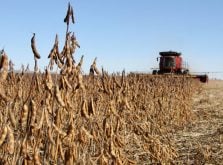Cows and cars need a little extra attention when temperatures plummet below -20 C and wind chills make it feel even colder.
Battleford, Sask., producer Greg Melchior keeps a close eye on his herd, looking for problems and ensuring the animals are well fed and watered.
“You just have to watch what your cattle need,” he said of his 60 head of Speckle Park.
He uses a quad and bale end roller to get feed to his animals in winter. This year, adding a cab to the quad has helped him battle the cold, said Melchior.
Read Also

Manitoba extends Crown land rent freeze
Manitoba government links the continued rental rate freeze on grazing and forage leases to economic and environmental challenges facing the industry
During ground checks of animals in the corrals or fields, he makes sure he dresses in plenty of layers. It’s the wind, not the cold, that bites, he said.
“Find as many clothes as possible,” he said, laughing.
He keeps his vehicles plugged in and uses synthetic oils to keep them running and uses a covered shed to get the tractors out of the wind. Walls of bales or windbreaks of carraganas can also be an effective block, he said.
“You can’t do anything about the cold but you need to get out of the wind.”
His cattle graze standing corn, with supplemental feeding not required until well into winter.
Melchior provides water daily for his animals, calling it a “cheap feed to help things go along.”
Bob Klemmer, beef forage specialist with Saskatchewan’s agriculture ministry, agreed good quality water is fundamental to herd health.
He recommended regular testing of the water source, citing an on-line water quality information tool that producers can plug their readings into for immediate results at www.agric.gov.ab.ca/app84/rwqit.
“The amount of water they drink is directly proportionate to the amount of feed they can eat,” he said, noting how cows will turn away from poor quality water and drink substantially less.
He also suggested unlimited access to hay during extreme cold snaps, increasing it by one third to one half and cutting back on straw.
“There may be some waste but it’s much better that cows are satisfied and not in a cold-stressed situation,” said Klemmer.
He cautioned against cows filling up on straw, saying it could lead to impaction in the gut and ultimately death.
Know the energy intake of animals and calculate the extra amount of hay required during weather below -15 C, said Klemmer.
“Below that temperature, their body requires more energy to keep warm.”
Ensure animals go into the winter with a good layer of fat and a condition score of 3 to 3.5.
“They then have 100 pounds of fat to burn off to stay warm as well,” said Klemmer.
Lactating females also need more feed to produce milk, he said, citing the need for good quality hay and grain to satisfy their nutritional needs.
He also stressed the importance of shelter for the herd and nursery barns for newborns.
“In -40 C weather, they can freeze their tails and ears really quickly, sometimes in less than 30 minutes.”
He recommended drying newborns at birth and keeping them in dry clean bedding.
Bob Cormier, a meteorologist with Environment Canada in Saskatoon, said the cold snap at the end of January brought brutal wind chills approaching -52 C to places like Brandon, and broke several temperature records across Saskatchewan. Like a bad head cold, the system was at its worst during the first three days, and lingered for seven to 10 days before moving off at the end of the week.
Cormier said there’s more bad news: the La Nina weather system will bring below-normal temperatures to the Prairies for the remainder of the winter and into the spring.














